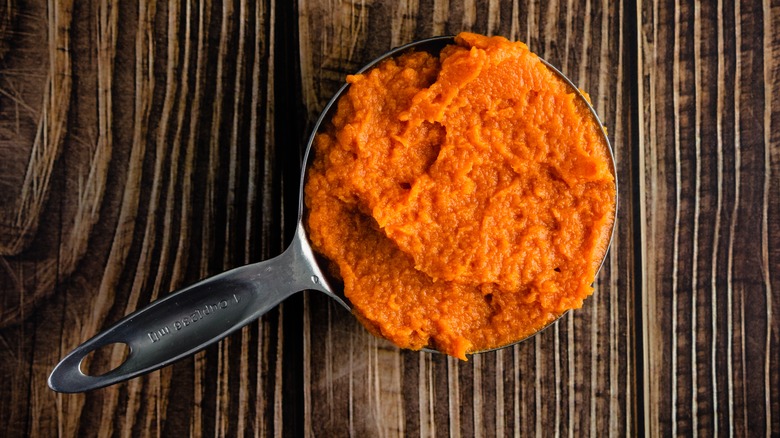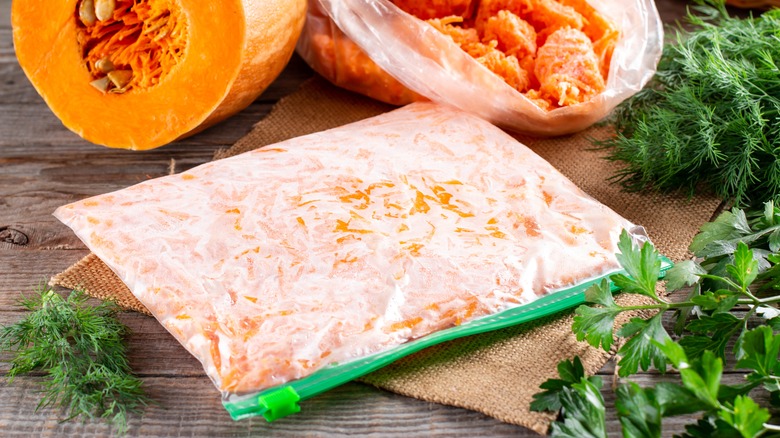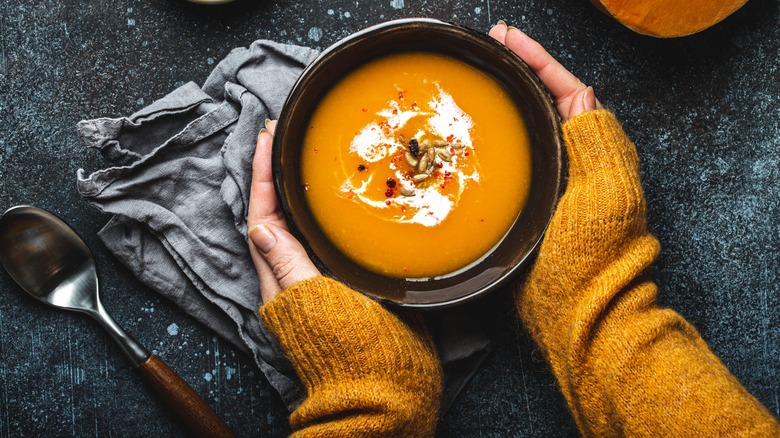The Best Way To Freeze Canned Pumpkin For Later
Pumpkins aren't just meant to spice up your latte. There are way more uses to these underrated winter squashes than you might think, from aiding in the creation of an extra creamy grilled cheese to a Thai-inspired coconut and pumpkin soup recipe. The best part is you don't even need to trouble yourself with gutting a fresh pumpkin to make use of this fruit. All you need to do is grab canned pumpkin from the grocery store and keep it properly stored until use.
There are a few ways to go about that, but for those who aren't planning on using up an entire can in one go, the best method would be to freeze it for later. As opposed to the few extra days it would've survived in the refrigerator, freezing your puree can make it last for up to seven to eight months. This extended shelf life will give you plenty of time to conjure up pumpkin-based recipes without worrying about any drastic changes to the puree's overall quality, taste, or nutritional value. You can even choose the best technique for freezing your product depending on how much of the stuff you have left over and how you plan to use it.
Methods of freezing pumpkin puree
One of the biggest storage mistakes ruining your food is refrigerating or freezing your goods in the can they came in. The frozen liquid within may cause the can to rupture or explode. When working with canned pumpkin, it's best to remove the food from its original container and instead use either a muffin tin, ice cube tray, or silicone versions of either of these. Muffin tins are a good option for those who use larger amounts of pumpkin puree in a particular recipe, while ice cube trays are better for smaller portions. Simply fill the compartments with the product, smooth the top out, and place them in the freezer. Once frozen, you can transfer the blocks into a sealed freezer bag if needed. A silicone tray will lend well to this part, as it makes it much easier to pop the frozen pieces out.
You can also skip the trays altogether and go straight to putting your pumpkin into a zip-top bag, though this might make you use more plastic than necessary depending on how you decide to divvy up the portions. Scoop the food into the freezer bag, and evenly distribute it so the bags don't have excess air and can take on as flat of a shape as possible. Then lay them down on a baking sheet in the freezer. Once they've become solid, you can stack them on top of each other or stand them up side by side to save space.
How to thaw pumpkin puree
Despite the fact that frozen pumpkin lasts several months as mentioned, it's ideal to use it up within the first three to four months to enjoy it at its best quality. Thaw it out only when you're ready to use it. Doing so is as easy as defrosting any other food. Remove the frozen bags or trays from the freezer, and place them in your fridge. Allow it a few hours or a night's worth of time to completely thaw out. For those who are in a bit of a time crunch, you can speed the process up by popping the frozen blocks into the microwave and utilizing the defrost button. If some excess water results from any of these methods, that's completely normal. Just drain the pumpkin using a mesh strainer to get rid of it.
It's best to use your pumpkin within three to five days of defrosting it. You can incorporate it into a solid amount of recipes out there. Whether it's pasta, bread, cookies, dips, or cheesecake, plenty of dishes can benefit from the mashed fruit's thick, silky texture and deeply unique flavor. However, if you still aren't able to finish your thawed puree using these meal ideas, avoid refreezing it. Doing so might alter its quality, which not only affect how your recipes come out, but also increase the possibility of food poisoning.


